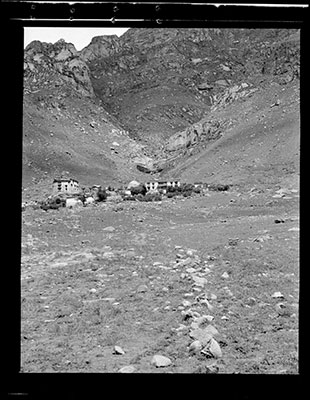
2001.59.2.67.1 (Film negative)


2001.59.2.67.1 (Film negative)

Hugh E. Richardson
Hugh Richardson
1950
Lhasa Area > Phabongka
2001.59.2.67.1
43 X 54 mm
Negative film nitrate
Donated August 2001
The executors of the estate of Hugh E. Richardson
Hugh E. Richardson
‘Mk’yen Brtse’s guide to the Holy Places of Central Tibet’, Alfonsa Ferrari, Rome: ISMEO, Serie Orinetale Roma XVI, 1958 [view list of illustrations]
Manual Catalogues - - Notes on front of negative album in Richardson's hand in white: '2' 'Ramagang, 'Ushang, Tshurphu rgyal, Misc pillars'. On the reverse of negative album written in blue ink on white labels in Richardson's hand: 'Hu zhang, Pa blon chen, Pha bong ka, Nyenchen thang lho, Rva sgreng, Khro 'brug, etc. etc.'
Manual Catalogues - Notes on negative index - Album 2, Folio. 67. 'Pha Bong' written in Richardson's hand in blue ink.
Manual Catalogues - Richardson's Hand List: Album no. 2: 44. 'Pha-bong kha. small monastery near Sera, said to be a very old foundation. '
Research publication - H. E. Richardson, High Peaks, Pure Earth' , London, Serindia Publications, 1998, plate 36. "Pha-bong-kha." [KC 09/11/2006]
Other Information - Location: Richardson discusses this site in High Peaks, Pure Earth , London, Serindia Publications, 1998, "In the valley to the west of Sera, the temple and small monastery of Pha-bong-ka (1947, 1950) stands on top of a great boulder on the hillside. It was traditionally a meditation place of Srong-brtsan Sgam-po and later of the first monks at the time of the phyi-dar, the later diffusion of the faith. ..." p. 305. See also, Victor Chan, Tibet Handbook, 1994, California, Moon Publications, "[Pabonka is] built on the lower slopes of Dhok Ri ... [It] is dominated by a three-story, circular building, a truncated tower that sits on top of a 20-m-high granite rock. (p. 130) ... The principal tower building contains a sacred stone statue of Sakyamuni and next to this structure are 108 chortens , perhaps built in the 7th century ..." (p.129)
Other Information - Setting: Pha bong kha is situated 8 km west of Lhasa, it is one of the oldest Buddhist sites in Tibet. The monastery is built around Do Phabong gi thang (rdo pha bong gu steng). The site is said to be be King Songtsen Gambo's (srong btsan sgam po) hermitage. The monastery is also said to be where Thomi Sambhota created the Tibetan script. The monastery and the surrounding choten were extensively rebuilt by the 5th Dalai Lama who also used the monastery as a retreat. At the time of Richardson's visit the monastery would have been similair to the structure created by the 5th Dalai Lama. [TS 22/3/2005]
Other Information - Dates: The date is derived from Richardson’s negative album No.4, the cover of which is marked with ‘Lhobrag 1950’. There are 16 images which share the same batch development number and seem to relate to a trip that Richardson took in this year, although Richardson also went to Phabongka in 1947 [Check this in High Peaks Pure Earth]. However, his preference for using 6x4.5 images, the smallest exposure size possible using his Zeiss Super Ikonta camera, seems to have returned only towards the end of his time in Tibet, possibly to maximise the number of images that he could take on each roll of film (16 using a film plane mask of this size or 8 at 6x9 cm) [MS 17/12/2005]
For Citation use:
The Tibet Album.
"Phabongka Monastery"
05 Dec. 2006. The Pitt Rivers Museum.
<http://tibet.prm.ox.ac.uk/photo_2001.59.2.67.1.html>.
For more information about photographic usage or to order prints, please visit the The Pitt Rivers Museum.
© The Pitt Rivers Museum